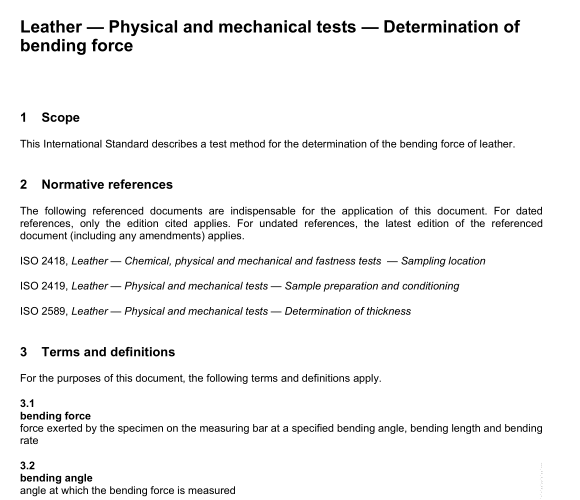ISO 14087 pdf download

ISO 14087 pdf download Leather — Physical and mechanical tests — Determination of bending force
4 Principle The bending force is determined based on the bar method (two-point bending method). In this method, the specimen is clamped in a rotating fixture. During the rotation, the specimen exerts a force onto a bar. The force acting at a specified bending angle is measured.
5 Apparatus
5.1 Device for determining the bending force according to the bar method (two-point bending method) comprising the following.
5.1.1 Clamping mechanism, in which the specimen shall be able to be clamped vertically. The clamping jaws shall have a depth of (35 1) mm and a minimum width of at least 30 mm (see Figure 1). The clamping device shall enable parallel clamping with an even pressure distribution on the specimen. It shall move smoothly and allow tightening with a torque wrench. The clamping device shall allow for affixing the specimen without it touching the bar in its initial position.
5.1.2 Means for rotating the clamping device about the pivot axis. The pivot axis is located exactly at the front edge of the fixed clamp (deviation of 0,1 mm) (see Figure 1). Rotation shall be possible within the range of 1° to 91° with a maximum deviation of 0,1°. The rotational speed shall be able to be adjusted up to 10 °/s with an accuracy of 0,1 °/s. At maximum load, the maximum deviation of the rotational speed allowed is 0,1 %.
5.1.3 Means of measuring the bending force. The rotation of the specimen causes it to be pressed against a vertical metering bar. (See Figure 2.) The bar is connected to a load cell that allows measurement of forces up to 10 N (optionally, 1 N for very flexible materials) with a minimum resolution of 0,1 % and a maximum deviation of 0,1 %. The bar design shall exhibit a sharp edge (R 0,05 0,01 mm) and a width of at least 30 mm. The weight of the bar shall not influence the measured value.
The distance between the bar and the pivot point shall be adjustable in a range from 0,1 mm to 50 mm with an accuracy of 0,1 mm. At the start of the measurement, the specimen is moved towards the bar until contact is made and a defined preliminary force is reached. This preliminary force shall be able to be adjusted with an accuracy of 1 mN. When the preliminary force is reached, the measurement shall start (angle 0° and force preliminary force setting). The evaluation unit shall ensure measurement of the force at one or more previously defined angles. These angles shall not be identical to the maximum angle of rotation. The measuring apparatus shall ensure that all significant parameters (force, length, speed) can be checked, calibrated and restored. It is recommended that the measured data (raw data and parameter settings) are able to be electronically archived.









